时间介词的应用
- 格式:doc
- 大小:29.00 KB
- 文档页数:8

时间介词in的用法
in一般用于表示一个较长的时间段,如几年、几个月、几周、几天、几小时等。
【常见搭配】
1. in +数字+年(years):表示“几年以后”,如:in five years(五年以后)
2. in +数字+月(months):表示“几个月以后”,如:in three months(三个月以后)
3. in +数字+周(weeks):表示“几周以后”,如:in two weeks(两周以后)
4. in +数字+天(days):表示“几天以后”,如:in ten days (十天以后)
5. in +数字+小时(hours):表示“几小时以后”,如:in two hours(两小时以后)
6. in +季节、月份等:表示“在某个季节、月份”,如:in summer(在夏季)、in April(在四月)
7. in +年数:表示“在某一年”,如:in 1987(在1987年)
【拓展】
除了表示一段时间以后的用法,in还可以有其他用法:
1.表示状况或状态的时间:如in trouble(陷入困境)、in love (恋爱中)
2.表示具体时间点内的时间:如in the morning(早上)、in the afternoon(下午)
3.表示在某些情况下的时间:如in case of emergency(在紧急情况下)
4.表示在某一状态或情境中的时间:如in public(在公共场合)。
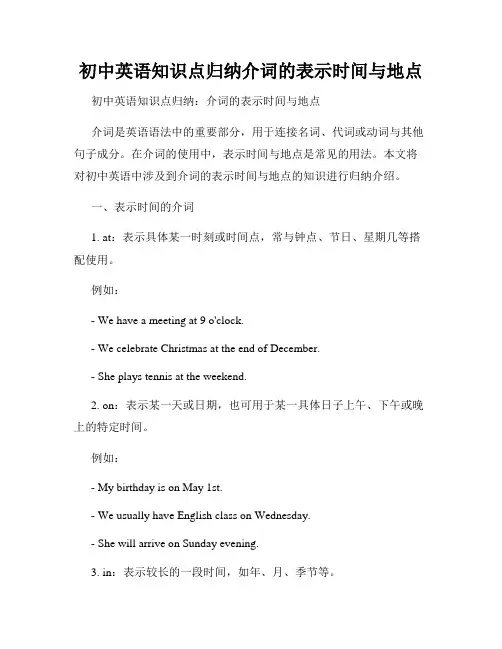
初中英语知识点归纳介词的表示时间与地点初中英语知识点归纳:介词的表示时间与地点介词是英语语法中的重要部分,用于连接名词、代词或动词与其他句子成分。
在介词的使用中,表示时间与地点是常见的用法。
本文将对初中英语中涉及到介词的表示时间与地点的知识进行归纳介绍。
一、表示时间的介词1. at:表示具体某一时刻或时间点,常与钟点、节日、星期几等搭配使用。
例如:- We have a meeting at 9 o'clock.- We celebrate Christmas at the end of December.- She plays tennis at the weekend.2. on:表示某一天或日期,也可用于某一具体日子上午、下午或晚上的特定时间。
例如:- My birthday is on May 1st.- We usually have English class on Wednesday.- She will arrive on Sunday evening.3. in:表示较长的一段时间,如年、月、季节等。
例如:- I was born in 2005.- He will go to Canada in the summer.- They always go skiing in January.4. during:表示在某一段时间内。
例如:- I read a book during the summer vacation.- They have a party during the New Year's holiday.5. for:表示持续的一段时间。
例如:- I have been learning English for five years.- They will stay in the hotel for a week.二、表示地点的介词1. in:表示在一个较大的范围或区域内。
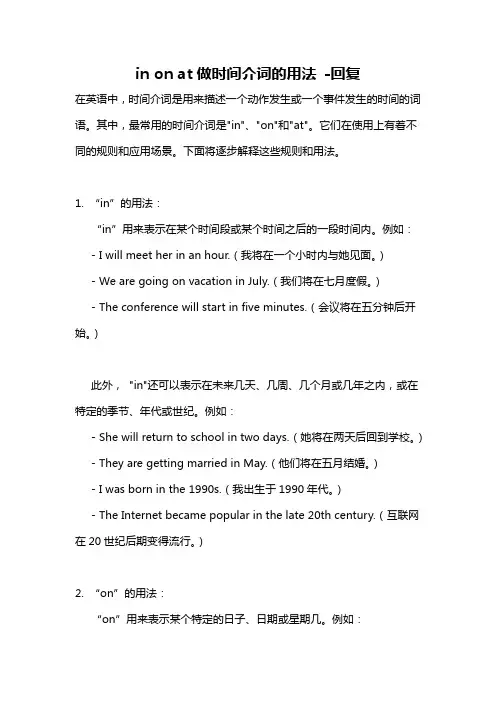
in on at做时间介词的用法-回复在英语中,时间介词是用来描述一个动作发生或一个事件发生的时间的词语。
其中,最常用的时间介词是"in"、"on"和"at"。
它们在使用上有着不同的规则和应用场景。
下面将逐步解释这些规则和用法。
1. “in”的用法:“in”用来表示在某个时间段或某个时间之后的一段时间内。
例如:- I will meet her in an hour.(我将在一个小时内与她见面。
)- We are going on vacation in July.(我们将在七月度假。
)- The conference will start in five minutes.(会议将在五分钟后开始。
)此外,"in"还可以表示在未来几天、几周、几个月或几年之内,或在特定的季节、年代或世纪。
例如:- She will return to school in two days.(她将在两天后回到学校。
)- They are getting married in May.(他们将在五月结婚。
)- I was born in the 1990s.(我出生于1990年代。
)- The Internet became popular in the late 20th century.(互联网在20世纪后期变得流行。
)2. “on”的用法:“on”用来表示某个特定的日子、日期或星期几。
例如:- I have a meeting on Monday.(我星期一有个会议。
)- Our anniversary is on March 15th.(我们的纪念日是在3月15日。
)- The concert will be held on Friday.(音乐会将在星期五举行。
)此外,“on”还可用于特定的假日或节日。
例如:- We celebrate Christmas on December 25th.(我们在12月25日庆祝圣诞节。
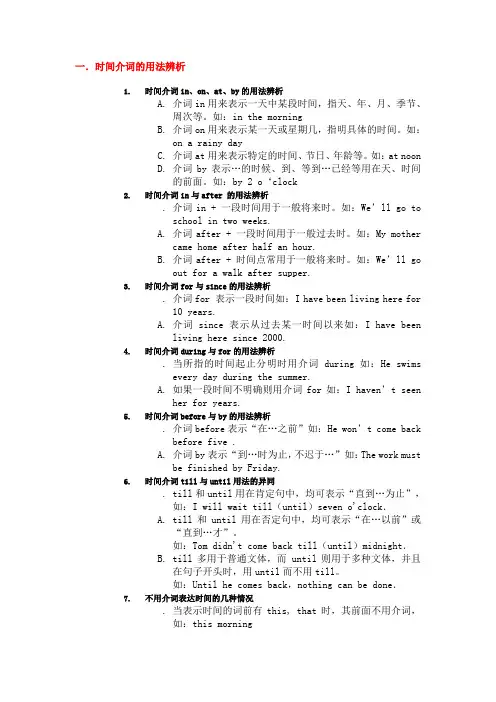
一.时间介词的用法辨析1.时间介词in、on、at、by的用法辨析A.介词in用来表示一天中某段时间,指天、年、月、季节、周次等。
如:in the morningB.介词on用来表示某一天或星期几,指明具体的时间。
如:on a rainy dayC.介词at用来表示特定的时间、节日、年龄等。
如:at noonD.介词by表示…的时候、到、等到…已经等用在天、时间的前面。
如:by 2 o‘clock2.时间介词in与after 的用法辨析.介词in + 一段时间用于一般将来时。
如:We’ll go toschool in two weeks.A.介词after + 一段时间用于一般过去时。
如:My mothercame home after half an hour.B.介词after + 时间点常用于一般将来时。
如:We’ll goout for a walk after supper.3.时间介词for与since的用法辨析.介词for 表示一段时间如:I have been living here for10 years.A.介词since 表示从过去某一时间以来如:I have beenliving here since 2000.4.时间介词during与for的用法辨析.当所指的时间起止分明时用介词during如:He swimsevery day during the summer.A.如果一段时间不明确则用介词for如:I haven’t seenher for years.5.时间介词before与by的用法辨析.介词before表示“在…之前”如:He won’t come backbefore five .A.介词by表示“到…时为止,不迟于…”如:The work mustbe finished by Friday.6.时间介词till与until用法的异同.till和until用在肯定句中,均可表示“直到…为止”,如:I will wait till(until)seven o'clock.A.till和until用在否定句中,均可表示“在…以前”或“直到…才”。

表示时间的介词用法一、表示较长时间(长于一天或短于一天)如:年、年份、月份、季节、周、上午、下午、晚上以及一些习惯用法中要用“in”。
1.in1996/in2002/in1847(年份)2.inOctober/in February/inMarch(月份)3.inspring/in summer/inautumn/ in winter(季节)4.inaweek/in ayear在1周/年中5.inthemorning /intheafternoon/ in theevening 在上午/下午/晚上inthosedays在当时/innotime立刻/inthedaytime在白天/inthefuture在将来/inoneminute在1分钟内/最后intheend二、表示时间的某一点(或表示某时刻)如:钟点、年龄或其它的习惯用法中要用“at1.atteno'clock/atseventhirty.(表示某一钟点)2.atnoon/atnight/atmidnight(在中午、晚上、半夜 -------------- 一天中相对短暂的时间)3.attheageoftwenty/attheageofthirty-five(表示某一年龄)4.atthattime在那时/atthemoment这时、那时、此刻/atfirst首先/ atlast最后=intheend/atonce立刻、马上/at/on(the)weekends在周末/在一年中的这个时候atthistimeofyear/在............... 开始/结束时atthebeginning/endof三、表示某一天或者特定(某一天上下午)的时间用“on”。
1.onMonday/onTuesday/onWednesday/onFriday2.onJanuary1/onApril18/onMay313.onJanuary1,1988/onApril18,2002/onMay31,19774.onMondaymorning/onTuesdayafternoon/onWednesdayevening5.ona wintermorning/onasummerevening/onaautumnafternoon6.onthemorningofMayfifth7.onmybirthday/onthatday/onNewYear'sDay/onthefirsttwodays/onChristmasDay8.值日onduty/准时ontime/四、表示持续一段时间用介词“for”。
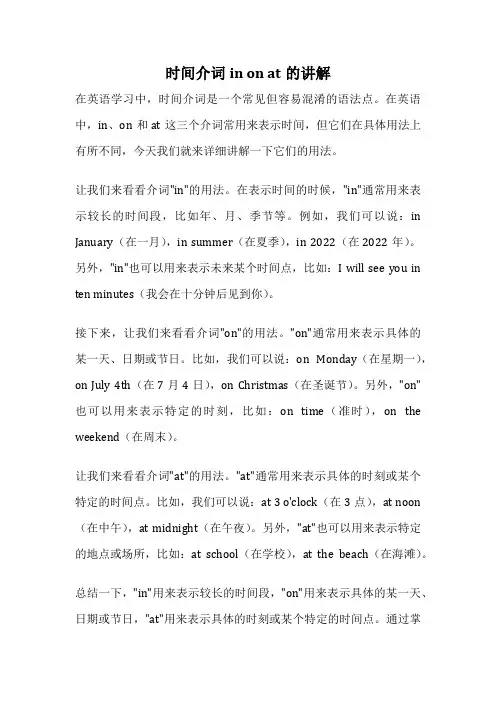
时间介词in on at的讲解在英语学习中,时间介词是一个常见但容易混淆的语法点。
在英语中,in、on和at这三个介词常用来表示时间,但它们在具体用法上有所不同,今天我们就来详细讲解一下它们的用法。
让我们来看看介词"in"的用法。
在表示时间的时候,"in"通常用来表示较长的时间段,比如年、月、季节等。
例如,我们可以说:in January(在一月),in summer(在夏季),in 2022(在2022年)。
另外,"in"也可以用来表示未来某个时间点,比如:I will see you in ten minutes(我会在十分钟后见到你)。
接下来,让我们来看看介词"on"的用法。
"on"通常用来表示具体的某一天、日期或节日。
比如,我们可以说:on Monday(在星期一),on July 4th(在7月4日),on Christmas(在圣诞节)。
另外,"on"也可以用来表示特定的时刻,比如:on time(准时),on the weekend(在周末)。
让我们来看看介词"at"的用法。
"at"通常用来表示具体的时刻或某个特定的时间点。
比如,我们可以说:at 3 o'clock(在3点),at noon (在中午),at midnight(在午夜)。
另外,"at"也可以用来表示特定的地点或场所,比如:at school(在学校),at the beach(在海滩)。
总结一下,"in"用来表示较长的时间段,"on"用来表示具体的某一天、日期或节日,"at"用来表示具体的时刻或某个特定的时间点。
通过掌握这三个介词在表示时间上的用法,我们可以更准确地表达时间概念,避免在表达时间时出现错误。

时间介词的用法 Last revised by LE LE in 2021时间介词的用法时间在英语当中是非常讲究逻辑性的东西,因此在时态上也多十多种分类。
(1)In:longperiodsoftime很长的一段时间,还可以表示某一段时间以后。
e.g.IamgoingtoDisneyworldinJune.我打算六月去迪士尼世界。
这里的月份六月是段很长的时间段,没有具体到那天,因此用in。
e.g.Ihavetowakeupin7hours.我必须在七小时后起床。
这个的7hours是指一个时间段以后的时间,因此要用in,用法和after相同。
e.g.Ihearhe’llbebackinamonth.我听说他将于一个月后回来.(2)On:specificdays具体的某一天,如节假日前。
e.g.Let’smeeton3rdofJanuary.我们在一月三日见面吧。
这个虽然有月份,但是3rd具体到了某一天,因此用on。
e.g.IwanttobeinNewYorkonNewYearsEve.我在除夕的时候去了纽约。
NewYearsEve作为一个节日,同样固定用法在前面加on。
e.g.Onmother'sDay,weshouldsendflowerstoourmother.母亲节,我们应该送花给我们的母亲.(3)At:specifictime具体的时间、具体的某个时刻。
e.g.Iwanttobedat3amlastnight.我昨晚凌晨3点才睡觉。
3am具体到了某个时刻,因此用at。
一些日常常见用法可以看下面表格:P.S.在表示年、月、日之前的介词,只要有日期,无论有年、月与否,都用on。
没有日期,无论是只有年,还是只有月,还是年、月都有,都要用in。

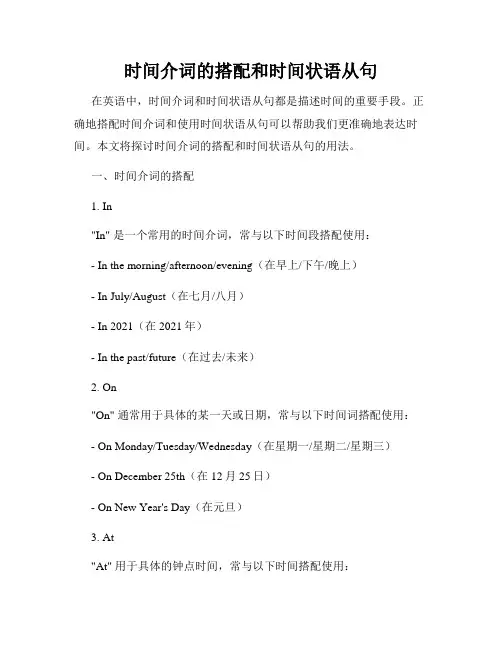
时间介词的搭配和时间状语从句在英语中,时间介词和时间状语从句都是描述时间的重要手段。
正确地搭配时间介词和使用时间状语从句可以帮助我们更准确地表达时间。
本文将探讨时间介词的搭配和时间状语从句的用法。
一、时间介词的搭配1. In"In" 是一个常用的时间介词,常与以下时间段搭配使用:- In the morning/afternoon/evening(在早上/下午/晚上)- In July/August(在七月/八月)- In 2021(在2021年)- In the past/future(在过去/未来)2. On"On" 通常用于具体的某一天或日期,常与以下时间词搭配使用:- On Monday/Tuesday/Wednesday(在星期一/星期二/星期三)- On December 25th(在12月25日)- On New Year's Day(在元旦)3. At"At" 用于具体的钟点时间,常与以下时间搭配使用:- At 9 o'clock(在9点)- At noon/midnight(在中午/午夜)4. During"During" 用于表示某个时间段内的全程,常与以下时间段搭配使用:- During the day(在白天)- During the summer/winter(在夏季/冬季)二、时间状语从句的用法时间状语从句可以帮助我们详细地描述一个事件发生的时间。
常见的引导词有:when(当...时候)、while(当...的时候)、until(直到...时候)、before(在...之前)和after(在...之后)。
以下是几个使用时间状语从句的例句:1. I'll call you when I arrive in Paris.(当我到达巴黎时,我会给你打电话。
)2. While I was studying, the phone rang.(当我正在学习的时候,电话响了。
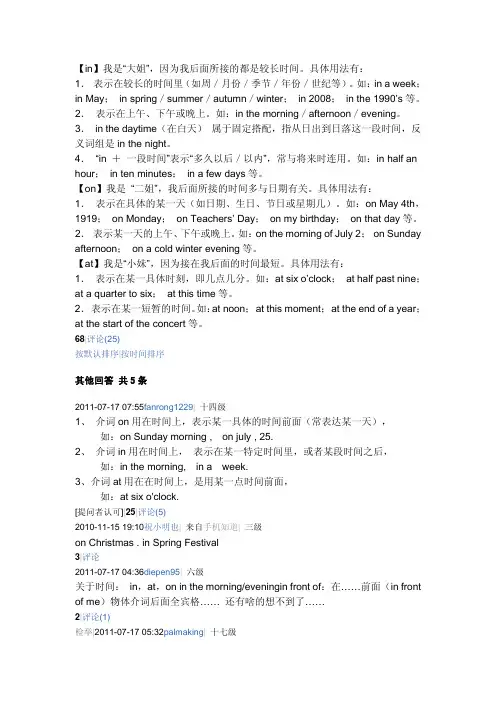
【in】我是“大姐”,因为我后面所接的都是较长时间。
具体用法有:1.表示在较长的时间里(如周/月份/季节/年份/世纪等)。
如:in a week;in May; in spring/summer/autumn/winter; in 2008;in the 1990’s等。
2.表示在上午、下午或晚上。
如:in the morning/afternoon/evening。
3. in the daytime(在白天)属于固定搭配,指从日出到日落这一段时间,反义词组是in the night。
4. “in +一段时间”表示“多久以后/以内”,常与将来时连用。
如:in half an hour;in ten minutes;in a few days等。
【on】我是“二姐”,我后面所接的时间多与日期有关。
具体用法有:1.表示在具体的某一天(如日期、生日、节日或星期几)。
如:on May 4th,1919; on Monday;on Teachers’ Day;on my birthday;on that day等。
2.表示某一天的上午、下午或晚上。
如:on the morning of July 2; on Sunday afternoon;on a cold winter evening等。
【at】我是“小妹”,因为接在我后面的时间最短。
具体用法有:1.表示在某一具体时刻,即几点几分。
如:at six o’clock;at half past nine;at a quarter to six;at this time等。
2.表示在某一短暂的时间。
如:at noon;at this moment;at the end of a year;at the start of the concert等。
68|评论(25)按默认排序|按时间排序其他回答 共5条2011-07-17 07:55fanrong1229|十四级1、介词on用在时间上,表示某一具体的时间前面(常表达某一天),如:on Sunday morning , on july , 25.2、介词in用在时间上,表示在某一特定时间里,或者某段时间之后,如:in the morning, in a week.3、介词at用在在时间上,是用某一点时间前面,如:at six o'clock.[提问者认可]|25|评论(5)2010-11-15 19:10祝小明也|来自手机知道|三级on Christmas . in Spring Festival3|评论2011-07-17 04:36diepen95|六级关于时间: in,at,on in the morning/eveningin front of:在……前面(in front of me)物体介词后面全宾格…… 还有啥的想不到了……2|评论(1)检举|2011-07-17 05:32palmaking|十七级记住,以下内容对中考和高考非常有用,要仔细阅读和背出来:in Januaryin winterin 1999;in the morning/ afternoon /evening.in the daytimeon Monday,on Sunday afternoon,on July 1st, 2011at six o’clock,at three thirty.at night,at noon,at this time of year.in a yearin springin Septemberin a week ,in two weeksin two weeks' timeon Mondayon Monday afternoonon March 7th, 2000at eight o’clockat this time of day /yearat the momentin the summer / winter holidayat Christmason Christmas Day / Eve / afternoonon the evening of May 31st,2011on National Dayon Children's Dayon the day of my arrival / departureon the day she comesin the year I was bornon the very Monday she fell illon Thanksgiving Dayduring our stay in Japanin Tom's absencein the presence of my friendson our way to the libraryon their first trip to Shanghaion a voyage inthe Atlantic Ocean。

英语语法介词如何表示时间的持续介词在英语语法中也被广泛用于表示时间的持续,帮助我们描述事件或行动发生的时间段或持续的时间。
下面是介词在表示时间持续方面的常见用法:1. during:-用于表示在某个时间段内(She studied during the summer,她在夏天期间学习)。
-用于表示在某个事件或行动期间(We had a picnic during the afternoon,我们在下午野餐)。
2. for:-用于表示一段时间的持续(He has been studying for two hours,他已经学习了两个小时)。
-用于表示某个事件或行动的持续时间(We stayed at the beach for the entire day,我们在海滩呆了整天)。
3. throughout:-用于表示在整个时间段内(She worked throughout the night,她整夜工作)。
-用于表示在某个事件或行动的整个过程中(He was smiling throughout the performance,他在整个演出过程中都一直在微笑)。
4. from...to:-用于表示从一个时间点到另一个时间点的持续(The store is open from 9 am to 6 pm,商店从早上9点到下午6点开门)。
-用于表示从一个事件或行动到另一个事件或行动的持续(He worked from Monday to Friday,他从周一工作到周五)。
5. since:-用于表示自从某个时间点以来的持续(She has been living in the city since 2010,她自2010年以来一直住在这个城市)。
-用于表示自从某个事件或行动发生以来的持续(I haven't seen him since the party,自从派对以来我就没见过他)。
6. from...until/till:-用于表示从一个时间点开始,一直持续到另一个时间点(The conference will take place from Monday until/till Friday,会议将从周一一直持续到周五)。
介词在日常生活中的应用有哪些在我们的日常生活中,介词虽然看似不起眼,但却发挥着极其重要的作用。
它们就像是语言中的“小螺丝钉”,虽然微小,却能让整个语言结构更加稳固和准确。
介词通常用来表示时间、地点、方向、方式等关系。
比如,“在早上”“在公园里”“朝东走”“用铅笔写字”等等,这里的“在”“朝”“用”就是介词。
先来说说时间方面的应用。
“在”这个介词在表示时间时非常常见。
“在周末”,我们可能会选择放松休息或者与家人朋友相聚;“在晚上”,城市的灯光亮起,人们结束了一天的忙碌;“在春节”,大家欢聚一堂,共度佳节。
“从”字也常被用于时间表述,“从周一到周五”,明确了一个时间段。
还有“自从”,“自从他离开后,我一直很想念他”,表达了从某个时间点开始的情况。
地点方面,“在”同样是使用频率很高的介词。
“在家”“在学校”“在超市”,这些表述让我们能清晰地知道所处的位置。
“到”字也不可或缺,“到北京”“到山顶”,指出了前往的目的地。
“于”字在一些正式或书面的表达中会出现,“生于上海”“长于农村”。
方向上,“向”“朝”“往”等介词能帮助我们准确传达位置的移动。
“向右转”“朝东行驶”“往北走”,让他人明白我们的行进方向。
方式方面,“用”是常见的介词。
“用筷子吃饭”“用手机拍照”“用电脑工作”,表明了完成某个动作所使用的工具或手段。
“以”字也有类似的作用,“以微笑待人”“以诚信为本”。
介词在描述位置关系时也功不可没。
“在……之上”“在……之下”“在……中间”“在……旁边”,这些表述让我们能够准确地描绘物体之间的相对位置。
比如,“书在桌子之上”“鞋子在床之下”“小明坐在我和小红中间”“花店在银行旁边”。
在表达原因和目的时,介词也有其独特的应用。
“因为”“由于”表示原因,“为了”则表示目的。
“因为下雨,所以我没出门”“由于工作繁忙,他经常熬夜”“为了考上好大学,他努力学习”。
介词还能用于描述涉及的对象和范围。
“关于”“对于”“至于”等介词能引导相关的话题和内容。
时间介词in的用法在英语中,时间介词”in”是一个常用且多功能的介词,它在不同情境下可以表示各种时间概念。
正确使用”in”这个介词可以帮助我们准确表达时间概念,下面我们来探讨一下”in”的用法及其相关例句。
首先,“in”可以用来表示某一时刻、某一特定时间段内的时间。
比如,我们可以说:- I have an appointment with the doctor in the afternoon. - The package is scheduled to arrive in two days. - She will start her new job in September.除了表示特定的时刻或时间段,“in”还可以表示一段时间的未来或过去。
例如: - The concert will take place in a week. - They plan to travel to Europe in the summer. - He learned to play the piano in his youth.另外,“in”还可以用来表示一段时间的延续。
比如: - I will finish the project in a couple of hours. - We will know the result in a few days. - The shop will close in ten minutes.此外,“in”还可以用来表示一种大致的时间范围或时期。
例如: - I will retire in about ten years. - He was born in the 1980s. - They will move to a new house in the near future.除了以上提到的用法外,“in”还可以用在其他情况下,比如表示某个月、季节、年龄、年代等。
例如: - Our anniversary is in May. - The flowers bloom in spring. - She got married in her twenties. - The film is set in the 1960s.总的来说,“in”作为一个时间介词在英语中使用频率很高,掌握其用法可以帮助我们更准确地表达时间概念。
介词in, on, at与年份搭配的用法(微反思)介词是英语中常用的一种词类,用于表示事物在空间、时间或关系上的位置或动态关系。
其中,介词in, on和at与年份的搭配有着一些特殊的用法。
本文将对这些用法进行简要介绍。
1. in与年份的搭配- in + 年份:表示一个具体的年份或日期范围。
例如:in 2021(在2021年),in the 21st century(在21世纪)等。
2. on与年份的搭配- on + 具体日期:表示某一具体日期。
例如:on September 1st (在9月1日),on New Year's Day(在元旦)等。
- on + 星期几:表示某一星期几的日期。
例如:on Monday(在星期一),on Fridays(在周五)等。
- on + 特定年份的节日或:表示某个特定年份的节日或。
例如:on Christmas Day in 2021(在2021年的圣诞节)。
3. at与年份的搭配- at + 黑体数字 + 年份:表示一个具体的年份。
例如:at 2000(在2000年)。
- at + 黑体数字 + 世纪:表示一个具体的世纪。
例如:at the20th century(在20世纪)。
此外,还有一些特殊的用法需要注意:- in/at + 年代:表示某个年代的时候。
例如:in the 1990s(在20世纪90年代)。
- in/at + 春季、夏季、秋季、冬季:表示某个季节的时候。
例如:in spring(在春季)。
- in/at + 早上、下午、晚上:表示一天中的某个时间段。
例如:at night(在晚上)。
以上就是介词in、on和at与年份的搭配的一些常见用法。
希望对您的研究有所帮助。
参考资料:- English Grammar in Use (4th Edition) by Raymond Murphy。
介词时间用法
介词在时间上的用法主要有以下几种情况:
1.表示在某个具体的时间点之前,常用介词“at”。
例如:at 8 o’clock早上八点钟。
2.表示在某个时间段之前,常用介词“before”或“by”。
例如:before 10 o’clock在十点之
前;by 12 o’clock在十二点之前。
3.表示在某个时间段之后,常用介词“after”。
例如:after 5 o’clock五点之后。
4.表示在某个时间段内,常用介词“within”或“in”。
例如:within the next hour在接下来
的一个小时内;in a week在一周内。
5.表示在某个时间段前后,常用介词“on”。
例如:on the day of the party在聚会的那一
天。
除了以上提到的介词外,还有一些其他的介词也可以表示时间,如“since”、“until”等。
需要注意的是,在使用介词表示时间时,要结合具体语境和语义来选择合适的介词。
1。
时间介词(at, in ,on) 的用法1. at(1)时间的一点、时刻等。
如:They came home at seven o’clock.(at night, at noon, at midnight, at ten o’clock, at daybreak, at dawn). (2)后面接表示岁数的词。
Children in China start school at 6 years old.(3)较短暂的一段时间。
可指某个节日或被认为是一年中标志大事的日子。
如: He went home at Christmas (at New Year, at the Spring Festival).2. in(1)在某个较长的时间(如世纪、朝代、年、月、季节以及泛指的上午、下午或傍晚等)内。
如:in 2004, in March, in spring, in the morning, in the evening, etc (2)在一段时间之后,常用于将来时。
He will arrive in two hours.These products will be produced in a month.3. on(1)具体的时日和一个特定的时间,如某日、某节日、星期几等。
如:On Christmas Day(On May 4th), there will be a celebration. (2)在某个特定的早晨、下午或晚上。
如: He arrived at 10 o’clock on the night of the 5th. (3)准时,按时。
如:If the train should be on time, I should reach home before dark.表示频率的副词用法详解一、常见的频率副词always,usually,often,sometimes, seldom,never.1) always表示的频率为100%,意思是"总是、一直、始终"。
at on of的用法一、介词“at”在句子中的应用介词“at”是英语中常见的一个介词,它有多种用法,下面将详细探讨几种常见的用法。
1. 表示时间:介词“at”通常用于表示具体的时间点。
例如,“at 8 o'clock”,“at noon”,“at midnight”。
此外,在描述节日或者特殊场合时,也可以使用介词“at”。
比如,“at Christmas”,“at the party”。
2. 表示地点:除了时间之外,在表示地点时,也可以使用介词“at”。
用于指明具体的位置或者场所。
例如,“at home”,“at the museum”。
3. 表示方式或状态:有时候,“at”可以用来表示某种方式或者状态。
例如,“look at”,“smile at”。
这种用法通常是针对某个动作或者状态的接收者进行描述。
二、介词“on”在句子中的应用1. 表示时间:与介词“at”相似,“on”也可用于表示时间,在这种情况下通常涉及到某一天、日期或星期几。
例如,“on Monday”,“on April 1st”。
2. 表示表面:当要描述某个物体上面的位置时,通常会使用介词“on”。
例如,“on the table”,“on the wall”。
3. 表示运输工具:在描述乘坐特定交通工具时,常需要使用介词“on”。
例如,“on the bus”,“on the plane”。
4. 表示发表言论:表示某人发表了意见、观点或者建议时,可以使用介词“on”。
例如,“He commented on the movie”,“I have something to say on this topic”。
三、介词“of”在句子中的应用1. 表示所属关系:介词“of”经常被用来表示所属关系。
例如,“the boo k of John”,“the handle of the door”。
这种用法强调某个物体属于或与之相关的人或物。
表示时间的介词称为时间介词。
表示时间的介词有:at, on, in, before, after等。
一、at, on和in① at 表示:(在(某时刻、时间、阶段),在……岁时)My cousin joined the army at fifteen.我表哥十五岁参的军。
② on 表示:在(某日),在周末,在……节日He was born on the 15th of August in 1769.他出生于1769年8月15日。
③ in 表示:在……事后,在……期间,在……年/月She went to America in 2000.她2000年去了美国。
at, on 和in 作时间介词的比较:① at 表示具体时间点。
② on 后可以跟表日期、星期、节日的词,还可以指具体某一天的早、中、晚。
③ in 泛指一天的早、中、晚,还可以表示一段时间,如:周、年、月、季节等。
二、before和after① before 表示:在……之前before eight o’ clock 八点之前Spring comes before summer.夏天之前是春天。
② after 表示:表示……之后after lunch 午饭之后Come to my office after school.放学后请来我办公室。
表示做某事的方法、手段的介词有by, with, in, at, on。
一、byby表示:用,以,靠,通过……方式。
by表示手段时后接动作或制作方式。
“by + 交通工具”表示交通方式。
by bike 骑车by bus 坐公车by taxi 搭出租by train 坐火车by ship 乘船by air 坐飞机Linda usually goes to work by subway.琳达通常做地铁上班。
She makes a living by teaching.她考教书谋生。
二、withwith 表示:用,以。
with表示手段时,后接工具、材料或具体内容。
write with a pen 用钢笔写eat with knife and fork 用刀叉吃see with one’s eyes 用眼睛看I killed the fly with a swatter.我用苍蝇拍打死那只苍蝇。
She cut the cake with a knife.她用刀切开了蛋糕。
三、inin 表示:用,以。
in表示用某种方式,如:颜色、笔墨、语言、声音、服饰等。
speak in English 用英语说talk in a high voice 高声说话I wrote a letter in ink.我用钢笔写了一封信。
Try to express yourself in English.试着用英语表达一下。
表示空间的介词有:at, in, on, over, above, under, below 等表示静态位置的介词和from, to, up, down, through, across 等表示动态方向的介词。
一、at, on 和in① at 表示:(地点、位置)在……② on 表示:(位置)在……上面③ in 表示:(地点、位置或空间)在……里,在……中,在……上Her fans have arrived at the airport.她的影迷已经到达了机场。
Look at the picture at the top of the page.请看以下这一项上面的图片。
Is my pen on the desk or in the desk?我的钢笔是在桌子上还是在抽屉里呢?Some kids are playing in the yard and others are playing in the room.有些孩子在院子里玩,其他则在房间里玩。
at,on 和in 作空间介词的比较① at用于表示一个较小的场合,这个地点被当作一个点来看待。
② on 表示在某一平面或线上,强调与某物体有接触。
③ in 表示在较大的地方,在某立体空间或平面范围之内。
二、about 和around① over 二者都表示:在……周围/各处,围绕。
但② above about强调无方向。
We walked about in the town.我们在城里到处游逛。
Dudu is running around the fence.嘟嘟在绕着篱笆跑。
Let’s plant trees around the house.让我们在房子周围栽上树。
三、over 和above① under 表示:在……正上方,越过② above 表示:在……上方I saw a wood bridge over the river.我看见河上有座木桥。
Look! Some birds are flying above the clouds.看!一些鸟儿在云朵上飞翔。
over和above作空间介词的比较① over强调在某人或某物的正上方,而且两物体表面没有接触。
② above 强调位置上某物体的上方,并不一定是正上方,而且两物体表面也没有接触。
四、under 和below① under 表示:在……的正下方② below 表示:在……下方Please read the words below the picture.请读图片下面的文字。
Look! A big mouse hides under the armchair.看!一只大老鼠躲在扶手椅下面。
under 和below 作空间介词的比较① under 强调在某物的下方,完全覆盖两物体表面可以接触也可以不接触。
② below 强调位置低于某参照物,但并不一定是正下方。
五、between 和among① between 表示:(位置、时间、数量等)在……之间(两者之间)② among 表示:在……中间(三者或三者以上之间)I often fly between Beijing and Shanghai.我经常在北京和上海之间飞来飞去。
Come here between eight and nine o’ clock.请把点到九点之间过来。
Susan is among the crowd.苏珊是人群当中。
六、into 和out of① into 表示:进来② out of 表示:出去Get out of the room.从房间里出去!Bob walked into the room.鲍勃走进房间。
He is working in the office.她在办公室里工作。
七、behind 和in front of① behind 表示:在……后面② in front of 表示:在……前面There is a fountain in the front of the park.公园的前面有一个喷泉。
Susan sits in front of me and Dudu sits behind me.苏珊坐在我前面,嘟嘟坐在我后面。
in front of classroom(在教室这个建筑的前面(教室的外面))in the front of classroom(在这个教室的前面(里面))(1) in front of 表示“在……的前面”(有一定距离的前面,也可以理解在物体范围外的前面),其反义词是behind,表示“在……的后面”。
例如:There is a river in front of the house. =There is a house behind the river.(2) 二者的区别:in the front of与in front of具有不同的含义。
前者表示在某一范围之内的前部,后者表示在某一范围之外的前面。
例如:There is a big desk in the front of the classroom. 在教室的前部有一张大桌子。
There is a tree in front of the classroom. 在教室的前面有一棵树。
八、up 和down① up 表示:往上,向……顶上② down 表示:往下,沿着……往下The monkey is climbing up the tree.猴子正在往树上爬。
Tears ran down her face.眼泪从她的脸上流了下来。
九、across 和through① across 表示:穿过,跨过② through表示:穿过,通过There is a bridge across the river there.那儿有座桥横跨在河上。
A train is running through the tunnel.一列火车正从隧道中穿过。
十、by 和near① by 表示:在……旁边② near 表示:在……附近Come over here and stand by me.过来站在我旁边吧。
We are planning to camp by the lake.我们打算到湖边露营。
There are some big apple trees near the house.房子附近有一些大苹果树。
The new hospital is near our school.新医院里我们学校不远。
十一、其他空间介词① along 表示:沿着,顺着② to 表示:到……,去……,向……Let’s walk along the street.让我们沿着街散散步。
We drove along the freeway.我们驱车沿着高数公路行驶。
The child pointed to the polar star.那孩子指着北极星。
I’m going to the bakery.我想要去那家糕饼店。
*第一个to表示“指”的方向、目标。
第二个to表示到达的目的地。
除了按上面介绍表示时间关系、空间关系、方式、手段等的介词外,还有一些重要的介词:一、of 的用法① of 表示:……的(表示所属、所有关系)a cover of this book这本书的封皮a friend of my parents我父母的一个朋友② of 表示:……之中的(表示部分)some boys of the team小组里的几个男生the end of the story故事的结尾Two students of our class joined in the match.我们班里的两个同学参加了这场比赛。
All of us approved his plan.我们全都赞成他的计划。
③ of 表示:……份/量的,……的种类的(表示量、种类)a drop of water一滴水a pair of shoes一双鞋I want two cups of coffee.我要两杯咖啡。